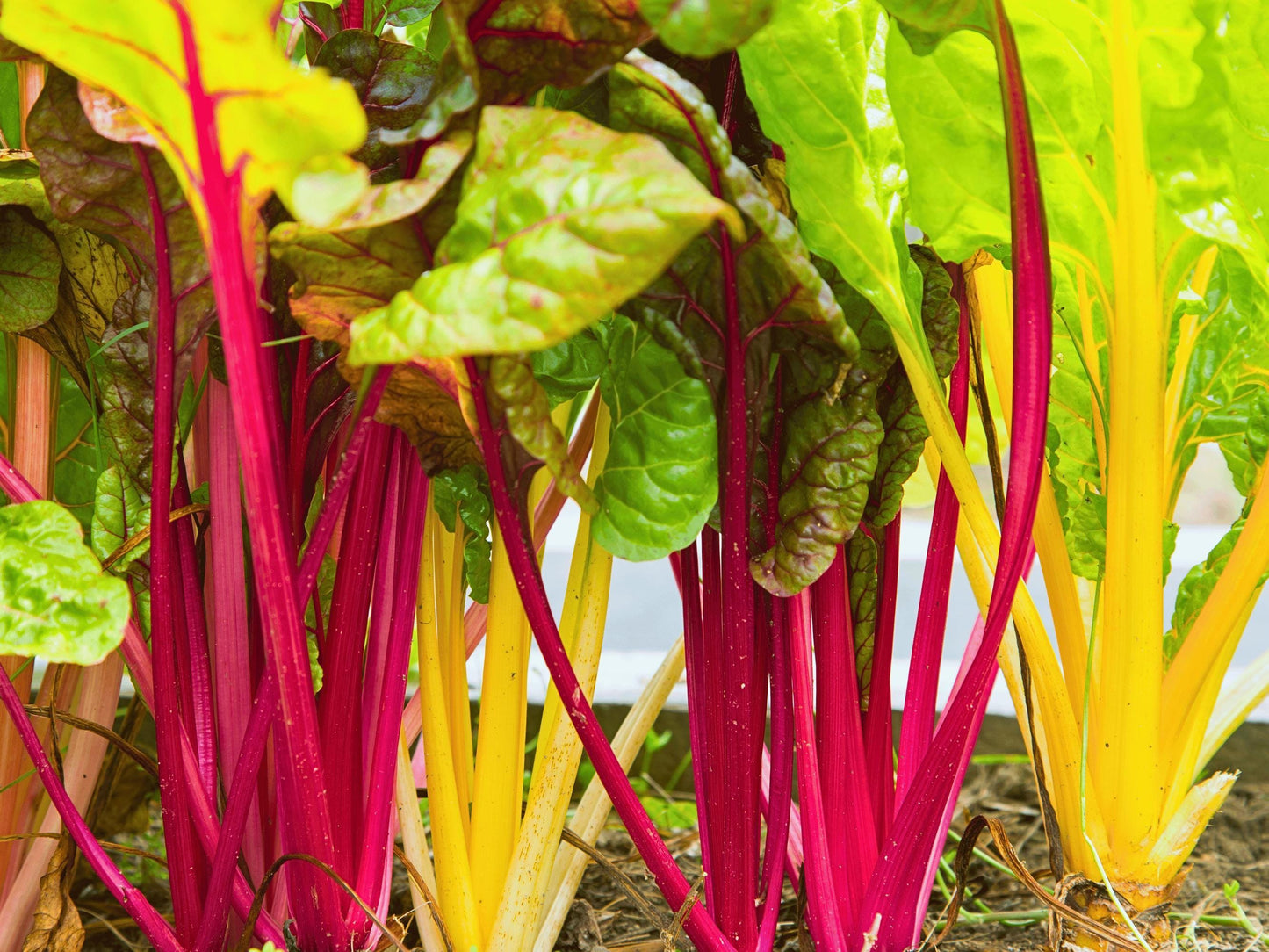Northern Lights Swiss Chard is an easy to grow stunning heirloom variety known for its vibrant, multi-colored stems and deep green leaves. This beautiful and nutritious leafy green brings a burst of color to your garden with its stunning display of red, yellow, pink, and white stalks. Beyond its visual appeal, Northern Lights is a productive and hardy crop that can be harvested continuously throughout the growing season, providing fresh, tender greens from spring to fall.
Swiss Chard is an incredibly versatile vegetable that thrives in various climates and can be grown in garden beds, containers, or as an ornamental border. It’s rich in vitamins A, C, and K, as well as minerals like iron and magnesium, making it a nutritional powerhouse. Whether sautéed, steamed, or used fresh in salads, Northern Lights Swiss Chard adds color, flavor, and nutrition to your meals.
* SCROLL DOWN FOR DETAILED GROWING INFO *
All Nimble NiteCap Seeds are:
• Heirloom
• Organic
• Non-GMO
• Open Pollinated
• Untreated
• US Grown
• Growing instructions included
• Regular testing is conducted to uphold the highest germination standards, all the while employing appropriate seed storage techniques.
Sustainable Packaging & Shipping:
• NimbleNitecap seeds are packed in eco-friendly, compostable seed packets. Seed packets are printed in-house with vegetable-based inks on biodegradable, recycled materials. (Small plastic bags are infrequently used to prevent the loss of very small seeds.)
• All orders are carefully packed and shipped with tracking via USPS First Class (or Priority, if selected) in padded ECOENCLOSE recycled and reusable mailers, or recycled boxes to protect your items in transit.
Most orders ship out the same or next business day! Please note that this time may be extended during peak season.
• FREE SHIPPING on all orders of $35 or more. Flat Rate shipping no matter how many packets you order.
* DIRECTIONS *
Common Names: Northern Lights Swiss Chard
Latin Name: *Beta vulgaris* subsp. *cicla*
Type: Leafy Green
Life Cycle: Biennial (Grown as an annual)
USDA Zones: 3 - 10
Stratification: Not required
Germination Ease: Easy
Sunlight: Full Sun to Partial Shade
Moisture: Prefers consistently moist, well-drained soil
Soil: Rich, well-drained soil with a pH between 6.0 and 7.5
Height: 18-24 inches
Spread: 12-18 inches
Color: Deep green leaves with vibrant red, yellow, pink, and white stems
Bloom Season: N/A (grown for leaves, not flowers)
Companion Plants: Excellent companions include tomatoes, beans, onions, and brassicas. Swiss Chard can help shade the soil and suppress weeds when planted among other crops.
Potential Toxicity: Non-toxic to humans and pets
Climate Adaptability: Adaptable to a range of climates within its USDA zones; tolerates both cool and warm weather, but performs best in moderate temperatures.
~ Sowing ~
When to Sow Outside: Sow seeds directly in the garden as soon as the soil can be worked in early spring, or in late summer for a fall crop.
When to Start Inside: Start seeds indoors 4-6 weeks before your last frost date for an early start.
Planting Depth: Sow seeds ½ inch deep.
Watering: Keep the soil consistently moist but not waterlogged. Chard prefers evenly moist soil for the best leaf production.
Light and Temperature: Chard prefers cooler temperatures between 60-70°F (15-21°C) but can tolerate warmer conditions. It can be grown in full sun or partial shade.
Germination: Seeds typically germinate in 7-14 days.
~ Transplanting Seedlings Outdoors ~
Timing: Transplant seedlings outdoors after the risk of frost has passed and the soil is warm.
Location: Choose a sunny location with well-drained soil. Partial shade can be beneficial in hotter climates.
Spacing: Space plants 12-18 inches apart to allow for adequate growth and air circulation.
Transplanting: Gently transplant seedlings into the prepared soil, ensuring the root ball is covered and the plant is stable. Water well after planting.
~ Growing ~
Watering: Water regularly to keep the soil evenly moist. Mulching can help retain soil moisture and keep roots cool.
Fertilizing: Chard benefits from a balanced fertilizer or compost worked into the soil before planting. A light side-dressing of compost or fertilizer can be applied every few weeks during the growing season.
Pest and Disease Management: Monitor for pests such as aphids and leaf miners. Use organic pest control methods such as insecticidal soap or neem oil if necessary. Ensure good air circulation to prevent fungal diseases.
Maintenance: Harvest outer leaves regularly to encourage new growth. Remove any yellowing leaves to keep the plant healthy and productive.
~ Harvesting ~
When to Harvest: Harvest outer leaves when they reach about 6-8 inches long. For a continuous harvest, pick leaves regularly while leaving the central growing point intact.
How to Harvest: Cut the leaves off at the base using scissors or a sharp knife. Avoid damaging the central growing point to allow the plant to continue producing.
Drying and Storing: Swiss Chard is best used fresh. Store harvested leaves in the refrigerator in a plastic bag or container for up to a week.
~ Seed Saving ~
Allow a few plants to flower and set seed in their second year if growing as a biennial. Once the seeds are mature and dry, collect them and store them in a cool, dry place for future planting.
~ Additional Information ~
Forage for Pollinators: N/A (Swiss Chard is grown for its leaves, not flowers)
Origin: Swiss Chard is believed to have originated in the Mediterranean region and has been cultivated for thousands of years for its nutritious leaves and stalks.
Nomenclature: The name "chard" comes from the French word "carde," meaning the stalks of artichokes. The "Swiss" part was added to distinguish it from French spinach varieties.
History: Northern Lights Swiss Chard is an heirloom variety known for its beautiful, colorful stems and nutritious leaves, making it a popular choice in gardens and kitchens alike.
Potential Toxicity: Non-toxic and safe for consumption by humans and pets.
Climate Adaptability: Prefers cooler temperatures but can tolerate a wide range of growing conditions; suitable for spring and fall planting in most regions.



















